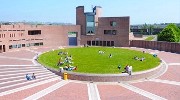Chemistry Researcher Published Book Chapter in Prestigious American Chemical Society Annual Text
Published on: Friday, 27 March 2009
Prof Kevin J. James (Director of PROTEOBIO) and Ambrose Furey (Director of Team Elucidate) from the Department of Chemistry have contributed to a book chapter in a text published by the American Chemical Society. This book titled ‘Food Contaminants, Mycotoxins and Food Allergens’ was produced following the Symposia on Mycotoxins and Food Allergens, held during the 232nd American Chemical Society (ACS) National Meeting in San Francisco, California, September 10 -14, 2006.
Mycotoxins are secondary fungal metabolites that are toxic to animals, humans and plants. Several toxigenic fungi are pathogenic to important cereal crops. Fumonisins, trichothecenes, zearalenone, and patulin occur in food crops as a result of a plant-fungus association; other important fungal borne toxins include, ochratoxin A and the aflatoxins. The toxins themselves encompass a wide range of compounds, several of which have been shown to cause disease in domestic animals and, less frequently, in humans. Approaches to controlling mycotoxins include attempts to prevent the formation of the toxins by the fungi, decreasing bioavailability of the toxins, and destroying toxins that have already been produced. The best solution to the problem of mycotoxins is to prevent their formation in crops in the first place, for example by competitive exclusion whereby non-aflatoxigenic strains of Aspergillus flavus or A. parasiticus are introduced onto the crops.
Monitoring of the occurrence and levels of mycotoxins in commodities and foods is necessary to divert contaminated materials from human and animal food supplies and it is important to estimate human exposure. Methods of analysis for mycotoxins include the use of immunoaffinity columns, multifunctional mixed bed immunoaffinity columns, molecularly imprinted polymers, liquid chromatography-tandem mass spectrometry, and qualitative and quantitative lateral flow methods. Examples of applications are methods of analysis for trichotheenes in cereal products, fumonisin BI in botanical roots, aflatoxin M1 in milk, aflatoxins in peanuts, and ochratoxin A in wine.
Food allergenicity is increasingly in the public spotlight. The underlying reason for the increasing rates of food allergy amongst western populations is a subject of continuing research. The cause may be environmental, including the exposure or lack of exposure to microorganisms, parasites, and immune challenges that separate the modem post-indust¬rial lifestyle from that of our ancestors. However, the increasing incidences of food allergies are certainly not fully understood and more research is needed to provide explanations. The public concern about the rising food allergy rates has been addressed by increased government regulation and intervention both in the United States and in many European countries.
The title of the chapter written by Prof Kevin J. James, Mr James Frahill (PhD student) and Dr Ambrose Furey was ‘Analysis of Trichothecenes using Liquid Chromatography Mass Spectrometry’ which reviewed all the previously published LC-MS methods used to provide both confirmatory and quantitative data on the levels of trichothecenes present in crop and processed food. LC-MS methods have now become the gold standard in the protection of human health from mycotoxin and allergen contamination.






